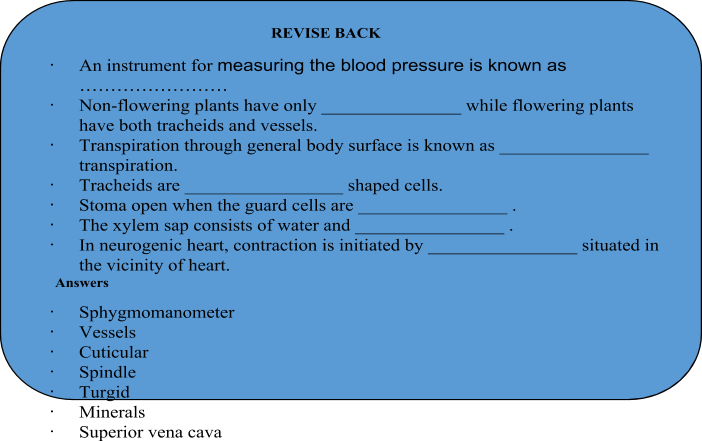
Circulatory System
Life Process of Class 10
The most purposeful function of the circulation is transport of nutrients to the tissues and removal of cellular excreta. Animal possess body fluids for this purpose. These fluids circulate throughout the body in order to perform their function. So circulatory system is a system of organs and structures which take part inflow of fluids for transport of materials inside an organism. The material transported through circulatory system include water, oxygen, carbon dioxide, nutrients, vitamins, hormones and waste products.In the body of organisms flow of fluid takes place in definite directions to move the substances.
Blood Vascular system of vertebrate
The human body consists of several organ systems. Each of the systems requires the involvement of circulating body fluids. There are two principal circulating fluids in our body, namely
Blood contained in the pump house or heart, and in the blood vessels (arteries, veins and capillaries) of the circulatory system. William Harvey (1728) discovered the circulation of blood.
L ymph present within the lymph vessels and the lymphatic organs (e.g., spleen and tonsils). With the help of blood and lymph, transportation of substances occurs in our body. In addition to transportation, blood and lymph have other functions to perform.
Blood
Blood is a fluid connective tissue having fluid matrix called plasma with red blood cells, white blood cells and platelets floating in it. It is bright red-colouredfluid that circulates in the entire body by the muscular pumping organ – the heart. The volume of blood is about 6 l . in adult human body.
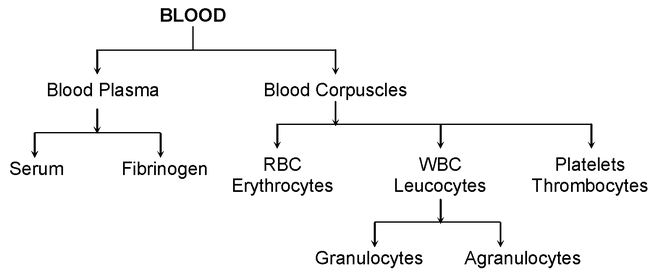
Composition of Blood
Blood contains three different kinds of cells or corpuscles present in a liquid matrix called plasma. Blood cells are manufactured in the bone marrow from stem cells.
Plasma: Plasma is the liquid part of the blood which contains 90 - 92% water. It also contains several salts, glucose, proteins, amino acids, fats, enzymes, hormones, antibodies and also digested and excretory products of food.
Serum is blood plasma from which fibrinogen, the blood clotting protein, has been removed. It is a yellow-coloured fluid.
Blood Cells : These are of three types
- Red blood cells or erythrocytes (RBCs)
- White blood cells or leucocytes (WBCs)
- Platelets or thrombocytes
RED BLOOD CELL
They are minute circular discs having no nuclei at maturity. In their cytoplasm is present a red pigment, haemoglobin, which is a protein with iron in its molecule. It has an affinity for oxygen and readily combines with it in conditions of high oxygen concentration. It forms an unstable compound called oxyhaemoglobin which, however, in conditions of low oxygen concentration readily breaks down and releases oxygen. This property makes it most efficient in transporting oxygen from the lungs to the tissues. There are about five-and-a-half million RBCs in a cubic millimetre of blood. A red blood cell lasts for about four months, after which it breaks down and is disintegrated in the liver or spleen. About 3 million RBCs are destroyed each day and about four times of this number are formed every day. RBCs are produced in the bone marrow.
WHITE BLOOD CELLS
They are much fewer in number than the RBCs ( 5,000 to 10,000 per cubic millimeter) and these cells possess a nucleus but no haemoglobin . They are larger than the RBCs in size and possess the power of amoeboid movement.The chief function of white blood cells is to defend the body against disease-germs. WBCs produce antibodies which are responsible for providing immunity . WBCs also ingest and destroy bacteria and dead cells by engulfing and digesting them.
PLATELETS
They are colourless, non - nucleated, irregular-shaped fragments of cells, with a very short life span of 3 - 5 days. They help in the clotting of blood.
FUNCTIONS OF BLOOD
Blood plasma transports food, carbon dioxide and nitrogenous wastes in dissolved form.
- RBCs transport oxygen with the help of hemoglobin.
- WBCs called soldiers of the body provide defense against diseases.
- Platelets cause clotting of blood at the site of injury to prevent excess loss of blood.
The heart:
The heart is a pumping muscularorgan which is as big as our fist. It receives blood from the veins and pumps it into the arteries. It is situated in the thoracic cavity which lies above the diaphragm between two lungs.
Structure of heart
Heart is a muscular pumping organ. The adult human heart is about the size of a closed fist. It is located in the chest cavity slightly towards the left, enclosed in a double walled sac called pericardium.
A pericardial fluid is present between the heart walland pericardium. The heart is made of muscle cells called cardiac muscle fibres. The heart consists of four chambers.
The upper two chambers constitute the right and left auricles or atria (signal atrium) and the lower two chambers form the right and left ventricles . The right and left sides are separated and do not ventricular aperture which is guarded by a valve called tricuspid. The valves permit the flow of blood from atrium to ventricle and not in the reverse direction.
Opening of right precaval is guarded by SA valve while opening of left precaval together with opening coronary sinus is guarded by Theobesian valve. Opening of post cavalis guarded by Eustachian valve. Left auricles has one opening of pulmonary vein having no valve. The right atrio-ventricular opening is guarded by tricuspid valve while left atrio-ventricular opening is guarded by bicuspid valve (mitral valve). Right ventricle opens into pulmonary aorta guarded by 3 semiluner (SL) valve and left ventricle opens into carotico-systemic aorta also guarded by 3 SL valves.Both these aorta in embryonic stage is connected through ductusaorticus (or ductusbotelli) which after birth degenerates and remain as ligamentumasteriosumm.
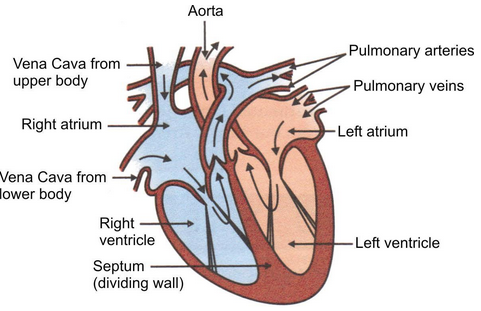
Working of the heart
In mammals and birds separation of the right side and left side of the heart is useful as it does not allow oxygenated and deoxygenated blood to mix. Such separation allows a highly efficient supply of oxygen to the body because these animals have high energy needs. They constantly use energy to maintain their body temperature. Hence the heart is four chambered in birds and mammals. Thus, the working of human heart is as follows :
- The oxygenated blood from lungs comes to thin walled left auricle through pulmonary veins .
- The de-oxygenated blood comes to thin walled right auricle through two large veins superior and inferior vena cava.
- When the left and the right atrium contracts, the oxygenated and deoxygenated blood reaches the respective ventricles.
- Contraction of ventricles results in transfer of blood from them into lungs and various body parts.
- Left ventricle on contraction sends oxygenated blood to body through the largest artery aorta . The aorta further sends blood to all the body parts. While the right ventricle pumps the blood into lungs for oxygenation through pulmonary artery.
Circulation of blood
The auricles are relatively thin-walled in comparison to the ventricles and receive blood from the veins. Oxygenated blood from the lungs enters the left auricle via the pulmonary vein and then enters the left ventricle through the bicuspid valve. From here, it is pumped to the body through the aorta.
Similarly, the deoxygenated or impure blood from the body tissues enters the right auricle from large vein called vena cava and then to the rigth ventricle through the tricuspid valve. From here, it is carried by pulmonary aorta to lungs for purification, i.e., reoxygenation.
In this way, deoxygenated blood comes to the heart; it is oxygenated in the lungs and brought back to the heart. From the heart, oxygenated blood is distributed to all parts of the body.
As the blood flows twice through the heart, it is called double circulation
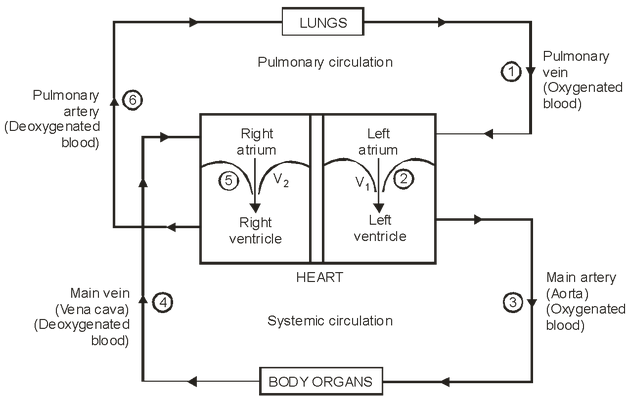
Block diagram showing double circulation in human body
Mechanism of Double Circulation: As the blood passes twice through the heart in one complete cycle in man, it is called double circulation.

Flow chart showing double circulation
Blood vessels
There are three types of blood vessels - arteries, veins and capillaries, connected to form a continuous system.
Arteries are fairly wide vessels which carry blood from the heart to different organs of the body. They are thick-walled, muscular and elastic, and deep seated in the body.
The arteries divide into smaller vessels, called artertioles, which themselves divide repeatedly until they form a dense network of microscopic vessels permeating between the cells of every living tissue. These final branches are called
capillaries.
Capillaries are narrow vessels with thin walls. The capillary walls are permeable, allowing water and dissolved substances other than proteins, to pass in and out. Through these thin walls, oxygen, carbon dioxide, dissolved food and excretory products are exchanged with the tissues around the capillary. Eventually, the capillaries unite into larger vessels, venules, which join to form veins and these return blood to the heart.
More active organ contains more number of capillaries (skeletal muscle 15 lakh/inch 2 ) while less or no active tissue have no capillaries e.g. in lens and cornea of our eye.
Blood sinuses are the blood spaces replacing capillaries in liver, spleen and bone marrow etc. with even thinner wall.
Veins carry blood from different organs to the heart. The blood pressure in them is steady and is less than the pressure in the arteries. They are wider and have thinner walls then the arteries. They also have valves in them which permit unidirectional flow of blood and thus prevent blood flowing away from the heart.
The blood in the veins usually contains less oxygen and dissolved food, and more CO 2 and nitrogenous waste material, while the arterial blood has a higher concentration of oxygen and dissolved food. Exceptions to this are the pulmonary artery which carries deoxygenated blood to the heart, the hepatic portal vein to the liver from the alimentary canal which carries blood rich in glucose and amino acids, and the renal vein from the kidney where some water, salts and urea have been eliminated.
Diseases of the Circulatory System
- Diseases of the circulatory system kill more people than any other illness. But these diseases are decreasing in number because of modern discoveries about their causes, treatment, and prevention.
Electrocardiogram
- The functioning of heart can be graphically recorded by an instrument called electrocardiograph.
- The heart muscles generate electric currents which bring about heart beats. The electrical changes during heart beat can be graphically recorded by placing electrodes on the chest above the heart and connecting the electrodes to a sensitive galvanometer with a recording device.
- The graphic recording is called an electrocardiogram (ECG).
- Pacemaker: In some heart patients, the heart does not beat normally. The muscle cells stop functioning. In such patients, a machine called pace maker is inserted in the patient’s heart, so that heart beats normally.
Blood pressure: It is the force that blood exerts against the wall of a vessel. This pressure is much greater in arteries than in veins.
- The presence of blood inside artery during contraction or ventricular systole is called systolic blood pressure .Pressure in artery during relaxation or ventricular diastole is called diastolic blood pressure .
- The normal systolic blood pressure is about 120 mm of Hg and diastolic blood pressure is 80 mm of Hg.
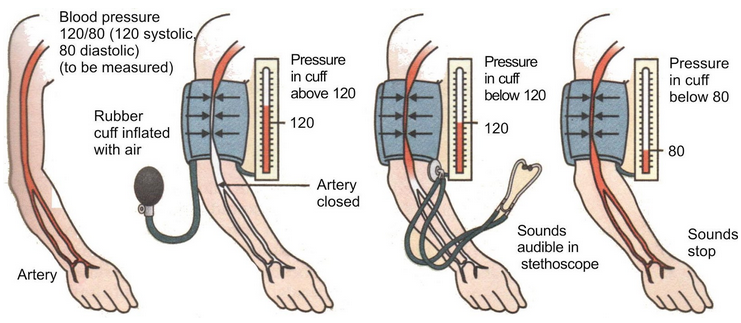
Blood Pressure
- Blood pressure is measured using an instrument called sphygmomanometer.
- Abnormally high blood pressure is called hypertension and it can lead to rupture of an artery.
Lymph
It is another type of fluid which also helps in transportation. This is formed by passage of some fluid from blood capillaries into intercellular spaces in the tissue through the pores present in the walls of capillaries.
- It is similar to the plasma of blood but colourless and contains very less proteins.
- Lymph drains into lymphatic capillaries from the intercellular spaces, these capillaries join to form large lymph vessels that finally open into larger veins.
The major functions of lymph are:
- It carries digested and absorbed fat from intestine into blood.
- It drains excess fluid from extra cellular space back into the blood.
- It provides immunity to the body.
TRANSPORTATION IN PLANTS
Transport system in plants is less elaborate than in animals. So, the only substances which are to be supplied to a plant through a transport system are water and minerals (which they can’t get from the air). Another job of the transport system of plants is to transport food prepared in the leaves to the various parts of the plants like stems, roots, etc.
The plants have two transport system :
- Xylem which carries water and minerals, and
- Phloem which carries the food materials which the plant makes (Phloem also carries the hormones made by the plants in their root and shoot tips).
The water and minerals dissolved in it move from the roots of the plant to its leaves through the two kinds of elements of the xylem tissue called xylem vessels and tracheids . Xylem vessels and tracheids are both non-living conducting tissues which have thick walls.
Transport of water
The xylem moves water and minerals obtained from the soil through roots to other parts of the plant. In xylem tissue, vessels and tracheids of the roots, stems and leaves are interconnected to form a continuous system of water-conducting channels reaching all plant parts.
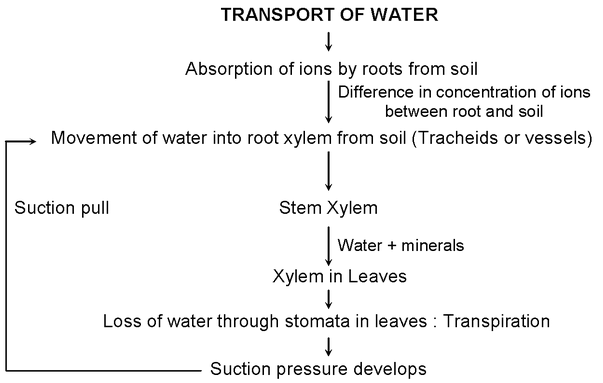
Thus, the two driving forces for the transport of water in the xylem are :
∙ Root pressure (more important at night)
∙ Transpiration pull
(a) Transpiration: It is defined as a process by which plants lose water in the vapour form from the aerial parts of the plant.
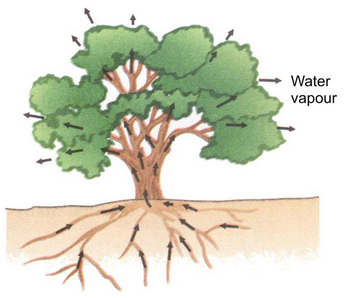
Movement of water during transpiration in a tree
(b) Importance of transpiration
(i) Ascent of Sap: It is the upward movement of cell sap, i.e. water and minerals through the xylem and excess of water is then lost in the form of water vapours after preparation of food.
(ii) Removal of Excess of Water: Transpiration helps to remove excess of water.
(iii) Cooling effect: It helps to regulate the temperature of plant since evaporation reduces temperature.
(iv) Absorption and Distribution of Salts: The continuous water current produced by transpiration helps to absorb and distribute the salts.
Transport of food substances
The phloem transports products of photosynthesis from the leaves where they are synthesized to other parts of the plant and storage organs.
The transport of soluble products of photosynthesis, amino-acids and other substances through phloem is termed translocation . The translocation of food and other substances takes place in the sieve tubes with the help of adjacent companion cells both in upward and downward directions. The translocation in phloem is achieved by utilizing energy. Materials like sucrose are transferred into phloem tissue by using ATP which increases the osmotic pressure of the tissue causing water to move into it. Thus, material in the phloem with high pressure moves to tissues with low pressure.
Xylem
- It is a tissue that transports water and dissolved minerals nutrients from the roots to all other parts of the vascular plant.
- Xylem consists of four kinds of elements :
(a) Vessels:
Vessels are cylindrical in shape with their ends open and are placed one above the
other.
(b) Tracheids:
They are elongated, thin, spindle-shaped dead cells with pits in their thick cell
walls.
(c) Xylem Parenchyma
(d) Xylem Fiber.
- Xylem vessels and tracheids are both non-living conducting tissues.
Phloem
- The food synthesised in the leaves and substances like hormones synthesised at the tips of roots and stems are transported to other parts of the plant through a conducting tissue called phloem.
- Phloem consists of sieve tube companion cells, phloem parenchyma and phloem fiber, which are placed one above the other forming continuous column with the ends covered with sieve plate.
- The movement of food materials and other substances through phloem depends on the action of living cells called sieve tubes.
- Thus, there is steady movement of water into root xylem from the soil, creating a column of water that is pushed upwards.
- Plant uses another strategy to move water in the xylem upwards to the highest points of the plant body.
- The water which is lost through the stomata due to transpiration is replaced by water from the xylem vessels in the leaf.
- Evaporation of water molecules from the cells of a leaf create a suction force, which pulls water from the xylem cells of roots.
- This loss of water due to transpiration helps in the absorption and upward movement of water and minerals dissolved in it from roots to the leaves.
- Transpiration becomes the major driving force in the movement of water in the xylem during the day when the stomata are open.
Difference between transport by xylem and phloem
|
S. No. |
Transport by xylem |
Transport by phloem |
|
1. |
Xylem absorbs water and minerals from soil and transports through roots, stems to the leaves. |
Phloem transports synthesized food from leaf to all plant parts. |
|
2. |
Transport is always unidirectional. |
Transport is bidirectional. |
|
3. |
In xylem transport does not require energy. |
In phloem, transport requires expenditure of energy in the from the ATP. |
MECHANISM OF TRANSPORT OF WATER AND MINERALS IN A PLANT
- The plants take in water (containing dissolved minerals) from the soil through their roots. This water (containing minerals) called sap is carried by the xylem vessels to all the parts of the plant.
- The roots of a plant have hair called root hairs . The function of root hairs is to absorb water and minerals from the soil. The root hairs are directly in contact with the film of water in between the soil particles. Water (and dissolved minerals) get into the root hairs by the process of diffusion.
- The water and minerals absorbed by the root hair from the soil pass from cell to cell by osmosis through the epidermis, root cortex, endodermis and reach the root xylem.
- The xylem vessels of the root of the plant are connected to the xylem vessels of its stem. So the water (containing dissolved minerals) enters from the root xylem vessels into stem xylem vessels. The xylem vessels of the stem branch into the leaves of the plants. So, the water and minerals carried by the xylem vessels in the stem reach the leaves through the branched xylem vessels which enter from the petiole (stalk of the leaf) into each and every part of the leaf. In this way, the water and minerals from the soil reach through the root and stem to the leaves of the plant.
- Only about 1 to 2 per cent of the water absorbed by the plant is used up by the plant in photosynthesis and other metabolic activities.
